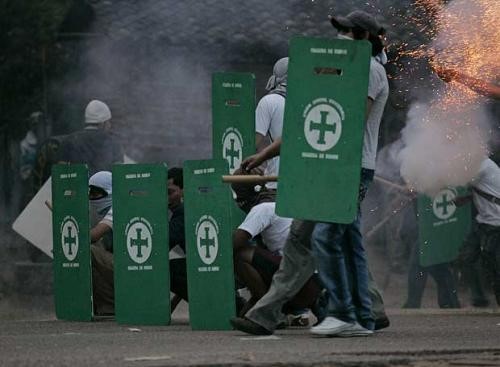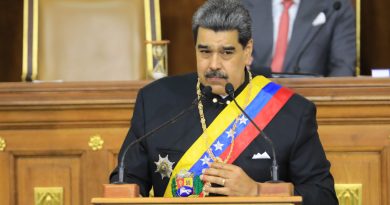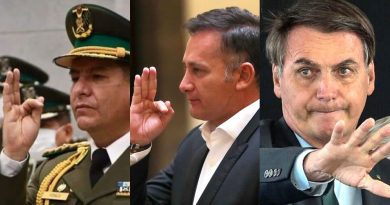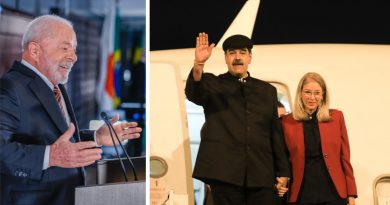A Closer Look at The Far-Right in Santa Cruz, Bolivia
By Cindy Forster
The far-right is again trying to unleash devastation from their stronghold in Bolivia’s largest city, Santa Cruz, in the lowland department of the same name, this time to liberate from jail the department’s governor, Luis Fernando Camacho. The governor shut down the city for over a month in late 2022 just after the courts had summoned him, and not for the first time, to declare his version of events during the coup of 2019. He refused to respond. Without his deposition, according to the justice system, there is no way to move forward with the case called “Coup d’Etat I” that charges coup leaders with crimes of terrorism. Camacho was finally arrested on December 28th for failure to comply with four summons. In response, another shutdown of Santa Cruz is now being attempted by his loyalists.
Many crimes exist for which Camacho could be charged, but he is awaiting trial in a maximum-security prison for the coup carried out over three years ago. That coup took the lives of dozens of civilians –most of them Indigenous– and ousted leftist president Evo Morales, also Indigenous. Camacho led the coup in the year 2019, assisted by the country’s oligarchy that mounted an elaborate scheme of lies. Camacho’s histrionic and hate-filled speeches whipped millions of anti-Indigenous citizens into a frenzy across the country. As they poured into the streets, Camacho was able to activate the well-oiled paramilitary machinery of the coup. In recent days, we learned he also apparently funded the betrayal of the police and the army. The time of terror began months before the ouster of socialist president Evo Morales, and Camacho was always at the center of planning. De facto president Jeanine Áñez –now serving a sentence for usurping the presidency– was groomed by Camacho. Because she feels that he abandoned her, Áñez just revealed that Camacho was a critical member of her government from behind the scenes. Camacho is awaiting trial in the department of La Paz.
One year after the violent expulsion of Evo Morales, the prodigious organizing of Bolivia’s Indigenous majority forced a presidential vote that freed Bolivia of the coup regime, in 2020. Since then, new coup attempts with Camacho at their helm have been constant. The Right managed to get him elected governor in Santa Cruz and are now insisting that he continue to govern from prison.
Camacho brought mayhem and mourning to Santa Cruz last November. The city came to a standstill with paramilitary violence in the working-class neighborhoods. Camacho’s thugs torched the regional headquarters of two of Bolivia’s leading social movements –the Federation of Campesino Workers of Santa Cruz and the Workers Federation of the Department– as well as the agency that protects public lands and forests. The building of the government TV channel in Santa Cruz was also stormed, terrorizing journalists and workers. In an echo of the burning of electoral tribunals during the coup of 2019, paramilitaries attacked the institute responsible for the census and for gathering statistics. As they set these fires, paramilitaries in the pay of Santa Cruz elites declared their intention to kill people.
Some analysts say Camacho’s paramilitary forces number around 5,000, contracted by the Pro Santa Cruz Civic Committee. That far-right club of businesspeople –led by Camacho during the coup– is now directed by Rómulo Calvo who was under house arrest and giving speeches at his front door. They use the Nazi salute. Elite youth are part of its paramilitary wing called the Union of Santa Cruz youth or UJC in the Spanish acronym. The attackers had also been recruited from “underneath the bridges” as a working-class individual said to the news cameras – from the criminal underworld. Journalists state that gangs controlled the right-wing blockades. Their practice of extortion was whitewashed as donations to the cause. On one newscast, a skinny, small child who had been collecting such donations managed to shimmy up the side of a bus through the window and into the bus driver’s lap, seeking refuge, as the bus was stopped at the blockade.
Police defense of the poor in Santa Cruz has been lukewarm. The city’s police commander was in a press conference with Camacho on the day the workers’ headquarters were pillaged and burned. As that destruction was taking place, Camacho asserted to the news cameras he was being persecuted. Reversal of the facts is a standard operating procedure for the right, though its efficacy seems to be wearing thin. Police are instructed to provide a barrier between the people and the paramilitaries, a crucial role, and a striking difference from the year of the coup when repression reigned from November 2019 to November 2020 and police served as the right’s hired thugs. In Santa Cruz, the right now insult the police as “traitors” because they have arrested a few aggressors at different moments.
Camacho is a master of false news and fascist rhetoric. He is a hero to the Right in Miami as well as Bolivia. He called his mercenaries burning buildings “neighbors,” then said that the social movements inflicted the damage on their own offices (where campesinos stay free of charge when they visit the city). Some 230,000 middle-class people packed the political meeting that consummated the paralysis of Santa Cruz in November, according to experts that measure the size of crowds. Cabildos or assemblies are the tool Camacho uses to claim a supposedly democratic mandate. MAS senator William Tórrez, an elder, explained, “On the 13th of November a new cabildo took place that violated Article 11 of the Constitution.” In theory, Article 11 “establishes a form of direct democracy with the people,” and in so doing, “the cabildo possesses an essential characteristic which is deliberation.” Collective discussion “makes known the people’s opinions, their demands and their conceptions.” Yet in the Santa Cruz cabildo, “there was absolutely no intervention uttered by a single person” from the crowd gathered there. One of the cabildo’s resolutions, incredibly, gave constitutional power to the so-called Interinstitutional Committee that called the assembly. The resolution charged the private-sector Interinstitutional Committee with carrying forward a federalist project. They also demanded freedom for prisoners who had committed outrages in the preceding days. In the subsequent weeks, the federalism of which they spoke came to sound more and more like a separate nation of Santa Cruz.
Across recent decades, the Pro-Santa Cruz Civic Committee has been beating people bloody on every occasion it has taken the streets. The Committee’s mass appeal rests on racism. Paramilitaries rape and kill their own, much less their enemies. Since the era of the coup that ended in November 2020, international human rights experts have called for arrests and trials of the UJC based on their cruel and deadly actions. Most of them remain free persons under the protection of the elite.
Not the entire Right of Santa Cruz stands with Camacho today. Conservative politician Vladimir Peña, a former Secretary General of the department of Santa Cruz, critiques him for believing he could “wrestle down” the national government, by repeating the street violence that greased the wheels for the overthrow of a constitutionally elected president in 2019. “He’s thinking only of his own political and personal advantage,” said Peña, at a moment when Camacho was defying a court summons and challenging the state to come arrest him in Santa Cruz. “Camacho has been in a bad situation for quite some time, with a terrible record of governance in Santa Cruz, problems of corruption, his Secretary [of Health] in clandestinity – he fled after the revelation of a compromising audio recording. With hospitals closed, precarity across the system of governance, institutional deterioration.” Peña concluded, “across the course of one year and a half” as governor, Camacho “did nothing at all.”
Santa Cruz Mayor Jhonny Fernández, a right-wing politician who has revealed the corrupt practices of other politicians on the right, is another outspoken critic of Camacho. For that, his home was attacked, and his family terrorized, including his pregnant daughter with a high-risk diagnosis. He said he will not participate in Calvo and Camacho’s latest call for shutting down the metropolis “because somebody has to work in this city.” Leaders of the main business associations of Santa Cruz recently said the same, as they watch factories flee the city for other regions of Bolivia after losses of 780 million U.S. dollars caused by the November blockades.
Even if the Right is fractured, its most fascist pole led by Camacho is nothing to scoff at. Chaos is always the lever Camacho uses to revive his political relevance. Last year he launched the city’s shutdown supposedly to shorten the length of time required to prepare an accurate census. That was the point of disagreement on which Camacho parted company with all the mayors and governors of Bolivia –many of them on the Right– to launch a so-called “civic strike.” It was a shutdown of the city by the oligarchs. It brought hunger to the poor, while the elites kept their factories running.
With constant calls for negotiation, the national government showed that Camacho’s insistence on a distinct census date ran counter to the advice of international experts and the decision of every other politician in the country. And in advance of the census results, MAS authorities conceded greater apportionment of political offices and resources to Santa Cruz. A leaked audio recording demonstrated the date of the census was merely a pretext, when right-wingers in a meeting recognized that their demand for a census in 2023 “was an impossibility.”
Reconfiguring mass resistance: Encirclement
In the department of Santa Cruz and also nationally, the masses are creating new strategies that mark a change from the coup year, and may signal a way out of the dominion imposed by the far Right in the city of Santa Cruz.
The poor did not try systematically to remove the right-wing blockades. Instead, neighborhood residents with their greater numbers encircled the blockaded streets.
Right-wing shock troops receive pay (and also liquor and illicit drugs which have led to gang rape and injuries –even death– in fights among themselves). They extort bribes at street blockades to allow individuals to pass through. Governor Camacho is the intellectual author of this behavior, together with the city’s far Right, and their call for escalation raised the number of injuries, as they knew it would.
“As women, we are standing guard here,” said a working-class woman on the barricades erected a bit distant from the blockades. “We, too, have the right to work. Our children have the right to study. They can’t just come here and attack us in this way,” she said, surrounded by other women. “We are not armed, unlike them,” showing to the camera the razor-sharp blades of a pinwheel the size of the palm of her hand and the munitions that had been thrown at them. “They say this is a ‘civic’ work stoppage. Lies! Look at what they have brought us, with the intention to kill.”
In October, news outlets barely reported Camacho’s characterization of the city shutdown he was planning – before it started, he declared it would be “beautiful.” A master of confusion, he insists paramilitary actions are peaceful and that he and his forces are the ones who are wronged.
By contrast, an uproar ensued in corporate media when the poor across Bolivia went to the aid of their brothers and sisters in Santa Cruz, peacefully, claiming their right to do so as Bolivians. The UJC attacked them as they arrived. They brutalized the marchers. When residents of Santa Cruz demanded the right to work, paramilitaries unleashed their fury against them in their home communities. The marches did not stop. From across the vast department, thousands of people with white flags mobilized. Their sheer numbers seem to have stayed the hand of the paramilitaries at various points.
Shutting down for real
Accomplishing the shutdown of the city “with greater seriousness” was another working-class strategy, though largely symbolic. The city is the location of the nation’s largest industrial sector and it stayed in business, at full operational capacity, through all the preceding shutdowns of the Right in Santa Cruz. This time, the poor declared they would monitor the elite closure of the city “for real,” and proceeded to close down access to the plants of the corporate oligarchs, mentioning Coca-Cola and national producers of cooking oil and milk products. The rich cried foul. They took their denunciations to the international forums of the global Right, demanding that the elite’s right to work be respected while denying that same right to the majorities.
The Right stays afloat with the backing of the United States. Even though the poor who vote for socialism massively outnumber the neo-fascist followers of Camacho, the present government brings charges gingerly. Criminals among the Right in Santa Cruz have largely evaded jail. To this point, the justice system has been unable to mount successful trials in cases of egregious human rights crimes committed during the coup year.
United in struggle, the socialist majority versus the fascist Right
On alert practically for the last two years, social movements have foreseen scenarios such the shutdown of cities by the Right. “We will not wait until it’s too late,” said a local leader to the state TV channel. Delegations of hundreds of people made their way to Santa Cruz and ringed the city.
Ovidio Mamani, regional executive of the leadership formation of the Andes called the Ponchos Rojos –an Indigenous vanguard of sorts that has led insurgencies historically and, in the present, served as a presidential guard and first line of defense for the MAS government– informed the nation: “The army of the youth of the Ponchos Rojos has been established.” They have joined in alliance with the organized youth of the department of La Paz and the youth of the city of El Alto. As a unit, the youth wing of the Ponchos Rojos are in training alongside their peers in El Alto. The same is true of the working-class organization of “motorcyclist youth in the Southern Zone of K’ara K’ara” in the city of Cochabamba, which protects the poor rather than attacking them like the paramilitary motorcyclists. “They are on alert, having declared a state of emergency … to protect our nation of Bolivia.”
This initiative responds to realities such as that described by a woman in Plan 3000 –a vast working-class sub-city of Santa Cruz– where “twenty hoodlums appeared in my neighborhood shouting, ‘We’re going to rob everything.’ They’ve recruited Venezuelans, Colombians, who knows from where all they’re bringing in these criminals.” Footage from a security camera showed Camacho’s paramilitaries shattering and breaking the camera. For all the crimes they committed that night in Plan 3000, “There was not a single person arrested. Nobody says a word.”
Neisa Najaya, Beni’s Departmental President of the Movement toward Socialism–Political Instrument, was furious: “This trampling and abuse of our brothers in Plan 3000 has to stop. Please, brother Lucho,” –she was in an assembly of women where President “Lucho” or Luis Arce was the honored guest– “help these brothers, because they will defend the Political Instrument to the death.” The speaker, an older woman, wore the green Indigenous dress of Beni. Thousands echoed her demands across the country in the meetings of the social movements.
Flora Aguilar, the national head of the Bartolina Sisas Confederation of Indigenous and Campesina Women –she is always cradling or breastfeeding her daughter as she addresses the public or raises her fist in the photos– asked President Arce the question being repeated everywhere outside of Santa Cruz: “Why aren’t you sending in the army?”
On October 28th, Indigenous Ayoreos on their ancestral lands were threatened by Daniel Velásquez with a whip in his hand. He is a sub-governor directly appointed by Camacho. Many of the Ayoreos have managed to avoid contact with outsiders in their nomadic life in the scrub forests of Santa Cruz, that are being bulldozed by rightwing ranchers. The sub-governor called the Ayoreos “an open sore.” Most of his victims were women. In various rural communities, the shirtless and furious Velásquez was burning down the homes of people protesting the elite shutdown.
The Ayoreo women did not retreat. In fact, they grabbed his traditional whip or chicote and gave him a small puncture wound in his back that he claims is a human rights violation. The Ayoreos have filed a case charging racism in the courts of the Interamerican human rights system.
With the attacks on social movement buildings, the anger of workers and peasants across Bolivia reached a fever pitch. Former president Evo Morales –who is now the head of the governing party, the Movement toward Socialism or MAS– urged people to avoid “provocations” by the Right. MAS politicians at the national and regional levels demanded respect for the lives and institutions of the people. María Nela Prada, the Minister of the President and highest-ranking member of the cabinet, said to the nation that “Governor Camacho and Rómulo Calvo have their hands stained with blood,” citing the deaths, suffering, racism, intolerance and hunger they caused in the elite shutdown of Santa Cruz.
President Luis Arce insisted the national government would not treat Santa Cruz with the brutality exercised by the coup regime. A certain inaction from the highest levels of MAS suggests they believe a stronger response would play into Camacho’s hand and rally the international forces of the Right to the defense of Camacho.
Camacho and his henchmen continue to announce they are on the path to overthrowing the national government, most recently via a separatist blueprint. The Indigenous take them at their word. The poor are not in any degree conciliatory. Alongside the Bartolina Sisas, other social movements demanded the militarization of the city of Santa Cruz and a state of emergency decreed by the national government.
“Today we stand in resistance to this launching of another coup d’etat,” said Flora Aguilar of the Bartolina Sisa Federation. “We cannot afford to wait and see what they will do next. We want prison for Camacho. We want prison for Calvo. We want prison for all of them who are killing our people. What they want is to create total chaos in our country to carry out another coup d’etat. The government has to wake up. The social movements cannot be fragmented. We must join forces and defend our democracy, our revolution, and our vote that we recuperated in the ballot boxes.”
So far, the patience of the national government and the principled stand of the social movements have held the line. Camacho’s civilian supporters are deciding to stay home, rather than join the marches called to liberate their hero.
For more news and analysis, check out our podcast Latin America Review: https://linktr.ee/latinamericareview



